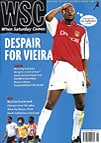 Ernst Bouwes looks at the largely positive expereince of black players in Holland, where the descendants of migrants from Surinam have become a powerful force in the national team
Ernst Bouwes looks at the largely positive expereince of black players in Holland, where the descendants of migrants from Surinam have become a powerful force in the national team
It is a well known fact that Peter Minuit bought Manhattan from the native Americans for the equivalent of about 30 dollars in 1626, but more obscurity surrounds the exchange of the same property for Surinam with the British some 40 years later. Among historians this is widely regarded as the worst real-estate deal of all time. One thing is certain though: not one person from the New York area ever made it into the England squad, while Surinam has produced dozens of talented footballers who have radically changed the look of the Dutch national team in the past 20 years.
The Dutch never really cared for the western colonies like they did for the East Indies, so there was some surprise when Surinam international Humphrey Mijnals came to play in Holland in the mid-Fifties. Mijnals was the first black player in Dutch professional football and would become the first to play for Holland in 1960. As a defender he marked his international debut with a legendary overhead kick just a couple of yards from his own keeper. Such an acrobatic trick was then regarded as a novelty in the lowlands.
More of his countrymen were invited to come over, but during the Sixties they could not really cope with the rapidly improving standard of the Eredivisie (the Dutch premier league) and mostly ended up at lower division teams. Although they certainly suffered from the odd racist remark, and perhaps worse, almost all of them stayed to build a life in their new country, and several saw their sons become professionals as well, like Frank Rijkaard and Brian Wilsterman, lately of Rotherham.
In 1975 Surinam gained independence, which resulted in an exodus of thousands of sceptical inhabitants to the Netherlands, where they could opt for Dutch citizenship and a more certain future. They gave up their Surinam passports, which meant that the current generation of black players in the Eredivisie are not eligible to play for their former country. Since the early Eighties an increasing number of black players have found their way into professional clubs. They could no longer be regarded as mere ball jugglers or dribble-meisters – the new black generation grew up in mist and wind whistling over muddy surfaces on freezing afternoons in the European winter.
Holland’s 2-0 defeat in a crucial World Cup qualifier against France in November 1981 would see the last all-white starting line-up in a Dutch national team. Ruud Gullit dominated the Eighties as the leader of the national team, winning the European Championship in 1988. However, it was not completely plain sailing. The players of Surinamese origin also quickly picked up the infamous art of debating, which the inhabitants of the Low Countries are widely known for. Bickering prevailed at the 1990 World Cup, where coach Leo Beenhakker never managed to put his finger on the sore spots.
Racism appeared to rear its ugly head at Euro 96, when Edgar Davids left the camp amid some wild accusations and the press made a big deal of the friendship between Patrick Kluivert, Clarence Seedorf, Winston Bogarde, Michael Reiziger and Davids, a group mystically christened “The Cabal”. Later it turned out the rows had more to do with the huge gap between the salaries of the young (coincidentally black) and older (mainly white) players at Ajax.
In the magnificent win over Germany in February 2000, Holland ended the game with no less than six Surinam-rooted players on the pitch. In his book Het Surinaamse legioen Dutch television journalist Humberto Tan revealed that in 1999 Paramaribo was the second most common birthplace for players in the Ere- divisie, Amsterdam being the first. And there is another invasion of talent coming up, as the offspring of the Mediterranean workers who came to Holland in the Sixties grow up. So in the future Jaap, Ruud, Clarence or Winston will most likely share the orange shirt with Ali and Mohammed. Total Football now seems to refer more to colour than to tactics.
From WSC 174 August 2001. What was happening this month